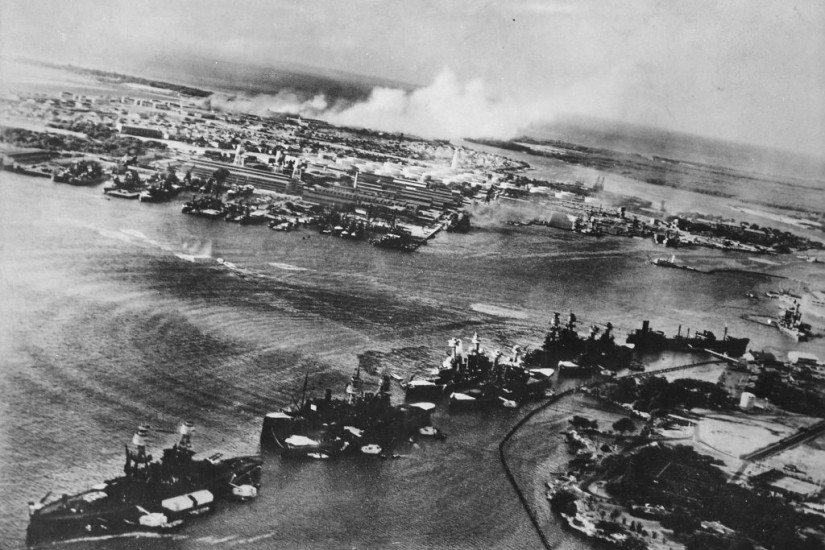Battlefield photographs ordinarily do not show much, being shot in haste, or from a safe distance. Usually they present one observer’s hazy corner of a large picture, leaving much to the imagination. This snapshot is a stunning exception, covering in clarity and detail much of a major battle, just after the combatants engaged.
Context
The scene is an aerial view looking southward over Pearl Harbor, Hawaii, shortly after sunrise on Sunday, December 7, 1941. At anchor in the foreground is the pride of the US Pacific Fleet, seven aging but still-powerful battleships. Starting from the bottom left corner and scanning rightward they are the USS Nevada; the Arizona, anchored beside the supply ship Vestal; the West Virginia and Tennessee moored together; with the Oklahoma and Maryland side-by-side and behind them. The USS California rests farther back, along the picture’s right edge, beyond the fleet oiler Neosho.
The photograph captures a moment when something violent has disturbed the tranquil morning. Japanese bombers had roared into the harbor only seconds before, dropping the torpedoes that left white streaks heading toward the American battleships. Several torpedoes have already hit the hulls of two ships, West Virginia and Oklahoma, and waves from their explosions are rippling back across the hitherto calm waters. A geyser from one hit can be seen alongside the West Virginia, rising as high as the battleship’s masts, and both the West Virginia and the Oklahoma are already listing to port. The Oklahoma will soon capsize in the shallow waters, trapping hundreds of sailors in her shattered hull.
We do not know just which Japanese aviator snapped this picture, but we can time it almost to the minute. The attack began about 7:53 am, and the USS Arizona still appears unscathed. Minutes later, at 8:06 am, a bomb will explode her ammunition magazine and break the ship in two. The aircraft crewman who captured this instant with his camera did so during that interval; he probably rode on a torpedo bomber climbing away from the harbor after dropping its ordnance.
The sky for now is still clear of smoke from burning ships and the black puffs of American anti-aircraft fire that would soon cloud the picture. For now the view extends to an air base in the distance; the white smoke in the background rises from Hickam Field, a US Army installation guarding Pearl Harbor. The Army and Navy had both received the same warning from Washington ten days earlier: be ready for war with Japan, but do nothing to alarm the civilian population. The Army’s commander in Hawaii understood those orders to include a danger of sabotage from Japanese agents, hence the planes at Hickam were lined up wingtip-to-wingtip, making them easier to guard but also leaving them easy targets for Japanese pilots bombing the field.
